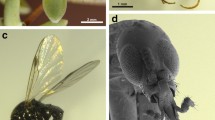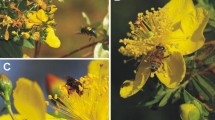Abstract
If on one hand, ant pollination is rare, on the other Asclepiadoideae flowers are the most complex among Eudicots. Both themes are exciting in pollination biology. Although there are records of ants with the ability to remove the pollinarium on this subfamily, the role of these insects as pollinators is not yet known. Therefore, we investigated the interaction between flowers and ants, as well as the associated features in two species of Asclepiadoideae, Ditassa capillaris and D. hastata. The studied species were both visited by Cephalotes inaequalis and Dorymyrmex thoracicus. We analyzed the common traits of ant pollination of the plant species, recorded the number of visit by ants, and carried out experiments of selective pollination, developing an effectivity index. Both Ditassa species have common traits of ant pollination, such as small bright flowers with exposed floral resource. The pollinarium is clip-shaped and resistant to the metapleural gland, which ensures effective pollination. Dorymyrmex thoracicus is a very frequent but not very efficient pollinator, whereas Cephalotes inaequalis is more efficient though at a lower frequency. Therefore, the total contributions of both ants to the pollination of both Ditassa species are similar. The features of both Ditassa species which favor ant pollination, include some synapomorphies within Asclepiadoideae. Furthermore, the efficiency of the ants as pollinators to the reproductive success of the plants was similar despite the different behaviors observed in both ant species. Hence, we suggest that the role of ants in pollination within this subfamily has been neglected.




Similar content being viewed by others
References
Ali T (1994) Pollination ecology of some asclepiads (Asclepiadaceae) from Pakistan. Dissertation, Universit of Karachi, Karachi
Andersen AN (1995) A classification of Australian ant communities, based on functional groups which parallel plant life-forms in relation to stress and disturbance. J Biogeogr 22:15–29
Andrade ML, Urbani CB (1999) Diversity and adaptation in the ant genus Cephalotes, past and present. Staatliches Museum für Naturkunde, Stuttgart
Andrade KVSA, Rodal MJN, Lucena MFA, Gomes APS (2004) Composição florística de um trecho do Parque Nacional do Catimbau, Buíque, Pernambuco - Brasil. Hoehnea 31:275–281
Bawa KS, Bullock S, Perry DR, Coville RE, Grayum MH (1985) Reproductive biology of tropical lowland rain forest trees. II. Pollination systems. Am J Bot 72:346–356
Beattie AJ (2006) The evolution of ant pollination systems. Bot Jahrb 127:43–55
Beattie AJ, Turnbull C, Knox RB, Williams E (1984) Ant inhibition of pollen function: a possible reason why ant pollination is rare. Am J Bot 71:421–426
Beattie AJ, Turnbull CL, Hough T, Knox RB (1986) Antibiotic production: a possible function for the metapleural glands of ants (Hymenoptera: Formicidae). Ann Entomol Soc Am 79:448–450
Betz RF, Struven RD, Will JE, Heitler FB (1994) Insect pollinators of 12 milkweed (Asclepias) species. In: Proceedings 13th North American Praire Conference, 45–60
Byk J, Del-Claro K (2010) Nectar- and pollen-gathering Cephalotes ants provide no protection against herbivory: a new manipulative experiment to test ant protective capabilities. Acta Ethol 13:33–38
Chaturvedi SK, Pant DD (1986) Further studies in the pollination of some Indian asclepiads. Bull Bot Surv India 28:23–30
Coombs G, Craig IP, Steven DJ (2009) A test for Allee effects in the self—incompatible wasp-pollinated milkweed Gomphocarpus physocarpus. Austral Ecol 34:688–697
Davidson DW, Cook SC, Snelling RR (2004) Liquid-feeding performances of ants (Formicidae): ecological and evolutionary implications. Oecologia 139:255–266
Dressler RL (1993) Phylogeny and classification of the orchid family. Cambridge University Press, Melbourne
Endress PK, Steiner-Gafner B (1996) Diversity and evolutionary biology of tropical flowers. Cambridge University Press, Cambridge
Faegri K, van der Pijl L (1979) The principles of pollination ecology. Pergamon, Oxford
Fenster CB, Martén-Rodríguez S (2007) Reproductive assurance and the evolution of pollination specialization. Int J Plant Sci 168:215–228
Fenster CB, Armbruster WS, Wilson P, Dudash MR, Thomson JD (2004) Pollination syndromes and floral specialization. Annu Rev Ecol Evol S 35:375–403
Forster PI (1994) Diurnal insects associated with the flowers of Gomphocarpus physocarpus E. Mey.(Asclepiadaceae), an introduced weed in Australia. Biotropica 26:214–217
Gómez JM, Zamora R, Hódar JA, García D (1996) Experimental study of pollination by ants in Mediterranean high mountain and arid habitats. Oecologia 105:236–242
Gordon DM (2012) The dynamics of foraging trails in the tropical arboreal ant Cephalotes goniodontus. PloS ONE 7:e50472. doi:10.1371/journal.pone.0050472
Hickman JC (1974) Pollination by ants: a low-energy system. Science 184:1290–1292
Hull DA, Beattie AJ (1988) Adverse effects on pollen exposed to Atta texana and other North American ants: implications for ant pollination. Oecologia 75:153–155
Ibarra-Isassi J, Sendoya SF (2016) Ants as floral visitors of Blutaparon portulacoides(A. St-Hil.) Mears (Amaranthaceae): an ant pollination system in the Atlantic Rainforest. Arthropod Plant Interact 10: 221–227
Kephart SR (1979) The floral ecology and reproductive isolation of three sympatric species of Asclepias. Dissertation, Indiana University, Bloomington
Koschnitzke C (2015) Um polinizador que pode morrer na flor. http://www.66cnbotanica.com.br/Content/Docs/livro_de_resumos.pdf. Accessed 29 February 2016
Lach L, Parr CL, Abott KL (2010) Ant ecology. Oxford University Press, Oxford
Lloyd DG (1992) Self-and cross-fertilization in plants. II. The selection of self-fertilization. Int J Plant Sci 153:370–380
Loveless MD, Hamrick JL (1984) Ecological determinants of genetic structure in plant populations. Annu Rev Ecol Syst 15:65–95
Machado IC, Lopes AV (2004) Floral traits and pollination systems in the Caatinga, a Brazilian tropical dry forest. Ann Bot 94:365–376
Martin C, Glover BJ (2007) Functional aspects of cell patterning in aerial epidermis. Curr Opin Plant Biol 10:70–82
Mondragón-Palomino M, Theiben G (2008) Mads about the evolution of orchid flowers. Trends Plant Sci 13:51–59
Niet TVD, Johnson SD (2012) Phylogenetic evidence for pollinator-driven diversification of angiosperms. Trends Ecol Evol 27:353–361
Ollerton J (1999) Fly trapping in Ceropegia flowers – evidence of ant predation of pollinators. Asklepios 77:31–32
Ollerton J, Sigrid L (1997) Pollination systems in the Asclepiadaceae: a survey and preliminary analysis. Biol J Linnean Soc 62:593–610
Ollerton J, Johnson SD, Cranmer L, Kellie S (2003) The pollination ecology of an assemblage of grassland asclepiads in South Africa. Ann Bot 92:807–834
Ollerton J, Killick A, Lamborn E, Watts S, Whiston M (2007) Multiple meanings and modes: on the many ways to be a generalist flower. Taxon 56:717–728
Pant DD, Nautiyal DD, Chaturvedi SK (1982) Pollination ecology of some Indian asclepiads. Phytomorphology 32:302–313
Peakall R, Beattie AJ (1989) Pollination of the orchid Microtis parviflora R. Br. by flightless worker ants. Funct Ecol 3:515–522
Peakall R, Beattie AJ (1991) The genetic consequences of worker ant pollination in a self-compatible, clonal orchid. Evolution 45:1837–1848
Peel MC, Finlayson BL, McMahon TA (2007) Updated world map of the Köppen-Geiger climate classification. Hydrol Earth Syst Sci 4:439–473
Proctor M, Yeo P, Lack A (1996) The natural history of pollination. Harper Collins, Portland
Puterbaugh MN (1998) The roles of ants as flower visitors: experimental analysis in three alpine plant species. Oikos 83:36–46
Ramsey M (1995) Ant pollination of the perennial herb Blandfordia grandiflora (Liliaceae). Oikos 74:265–272
Rapini A (2002) Six new species of Ditassa R. Br. from the Espinhaço Range, Brazil, with notes on generic delimitation in Metastelmatinae (Apocynaceae-Asclepiadoideae). Kew Bull 57:565–583
Rapini A (2012) Taxonomy “under construction”: advances in the systematics of Apocynaceae, with emphasis on the Brazilian Asclepiadoideae. Rodriguésia 63:75–88
Rico-Gray V (1989) The importance of floral and circum-floral nectar to ants inhabiting dry tropical lowlands. Biol J Linn Soc 38:173–181
Shuttleworth A, Johnson SD (2012) The Hemipepsis wasp-pollination system in South Africa: a comparative analysis of trait convergence in a highly specialized plant guild. Bot J Linn Soc 168:278–299
Silva NMF, Valente MC, Pereira JF, Filho GMA, Andrade LR (2008) Morfoanatomia de espécies brasileiras de Oxypetalum (Asclepiadoideae-Apocynaceae). Rodriguésia 59:915–948
Solbrig OT, Rollins RC (1977) The evolution of autogamy in species of the mustard genus Leavenworthia. Evolution 31:265–281
Solbrig OT, Curtis WF, Kincaid DT, Newell SJ (1988). Studies on the population biology of the genus Viola. VI. The demography of V. fimbriatula and V. lanceolata. J Ecol 76:301–319
Torres-Contreras H, Vasquez RA (2004) A field experiment on the influence of load transportation and patch distance on the locomotion velocity of Dorymyrmex goetschi (Hymenoptera, Formicidae). Insect Soc 51:265–270
Torres-Contreras H, Vasquez RA (2007) Spatial heterogeneity and nestmate encounters affect locomotion and foraging success in the ant Dorymyrmex goetschi. Ethology 113:76–86
Tucker SC (1997) Floral evolution, development, and convergence: the hierarchical significance hypothesis. Int J Plant Sci 156:143–161
Vasconcelos HL, Vilhena J, Magnusson WE, Albernaz AL (2006) Long-term effects of forest fragmentation on Amazonian ant communities. J Biogeogr 33:1348–1356
Vega C, Herrera CM (2013) Microorganisms transported by ants induce changes in floral nectar composition of an ant-pollinated plant. Am J Bot 100:792–800
Vega C, Arista M, Ortiz PL, Herrera CM, Talavera S (2009) The ant pollination system of Cytinus hypocistis (Cytinaceae), a Mediterranean root holoparasite. Ann Bot 103:1065–1075
Vieira MF, Fonseca RS, Shepherd GJ (2012) Morfologia floral e mecanismos de polinização em espécies de Oxypetalum R. Br. (Apocynaceae, Asclepiadoideae). Rev Bras Bioc 10:314–321
Wagner D (2000) Pollen viability reduction as a potential cost of ant association for Acacia constricta (Fabaceae). Am J Bot 87:711–715
Wiemer AP, Sérsic AN, Marino S, Simões AO, Cocucci AA (2011) Functional morphology and wasp pollination of two South American asclepiads (Asclepiadoideae– Apocynaceae). Ann Bot 109:77–93
Wolff D, Meve U, Liede-Schumann S (2008) Pollination ecology of Ecuadorian Asclepiadoideae (Apocynaceae): how generalized are morphologically specialized flowers? Basic Appl Ecol 9:24–34
Wyatt R (1981) Ant-pollination of the granite outcrop endemic Diamorpha smallii (Crassulaceae). Am J Bot 68:1212–1217
Yanoviak SP, Dudley R, Kaspari M (2005) Directed aerial descent in canopy ants. Nature 433:624–626
Acknowledgements
We thank to Coordenação de Aperfeiçoamento de Pessoal de Nível Superior (CAPES) by master scholarship of ADM; to Dr. Diego Sotero Pinangé for reviewing our English; to Conselho Nacional de Desenvolvimento Científico e Tecnológico (CNPq) for a research grant to ICM and for financial support through Programa Ecológico de Longa Duração (PELD/Catimbau).
Author information
Authors and Affiliations
Corresponding author
Additional information
Handling editor: Isabel Alves dos Santos.
Rights and permissions
About this article
Cite this article
Domingos-Melo, A., Nadia, T.d.L. & Machado, I.C. Complex flowers and rare pollinators: Does ant pollination in Ditassa show a stable system in Asclepiadoideae (Apocynaceae)?. Arthropod-Plant Interactions 11, 339–349 (2017). https://doi.org/10.1007/s11829-017-9499-3
Received:
Accepted:
Published:
Issue Date:
DOI: https://doi.org/10.1007/s11829-017-9499-3




